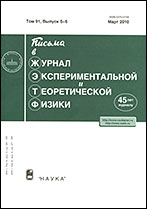|
|
Pis'ma v Zhurnal Èksperimental'noi i Teoreticheskoi Fiziki, 2007, Volume 86, Issue 10, Pages 713–717
(Mi jetpl912)
|
 |
|
 |
This article is cited in 22 scientific papers (total in 22 papers)
FIELDS, PARTICLES, AND NUCLEI
Universal description of the rotational-vibrational spectrum of three particles with zero-range interactions
O. I. Kartavtsev, A. V. Malykh
Joint Institute for Nuclear Research
Abstract:
A comprehensive universal description of the rotational-vibrational spectrum for two identical particles of mass $m$ and the third particle of mass $m_1$ in the zero-range limit of the interaction between different particles is given for arbitrary values of the mass ratio $m/m_1$ and the total angular momentum $L$. It is found that the number of vibrational states is determined by the functions $L_c(m/m_1)$ and $L_b(m/m_1)$. Explicitly, if the two-body scattering length is positive, the number of states is finite for $L_c(m/m_1)\le L\le L_b(m/m_1)$, zero for $L > L_b(m/m_1)$, and infinite for $L < L_c(m/m_1)$. If the two-body scattering length is negative, the number of states is zero for $L\ge L_c(m/m_1)$ and infinite for $L < L_c(m/m_1)$. For the finite number of vibrational states, all the binding energies are described by the universal function $\varepsilon_{L N}(m/m_1)=\mathcal E(\xi,\eta)$, where $\xi={(N-1/2)}/{\sqrt{L(L+1)}}$, $\eta=\sqrt{m/{m_1 L (L+1)}}$, and $N$ is the vibrational quantum number. This scaling dependence is in agreement with the numerical calculations for $L > 2$ and only slightly deviates from those for $L=1, 2$. The universal description implies that the critical values $L_c(m/m_1)$ and $L_b(m/m_1)$ increase as $0.401\sqrt{m/m_1}$ and $0.563\sqrt{m/m_1}$, respectively, while the number of vibrational states for $L\ge L_c(m/m_1)$ is within the range $N\le N_{\max}\approx1.1\sqrt{L(L+1)}+1/2$.
Received: 26.09.2007
Citation:
O. I. Kartavtsev, A. V. Malykh, “Universal description of the rotational-vibrational spectrum of three particles with zero-range interactions”, Pis'ma v Zh. Èksper. Teoret. Fiz., 86:10 (2007), 713–717; JETP Letters, 86:10 (2007), 625–629
Linking options:
https://www.mathnet.ru/eng/jetpl912 https://www.mathnet.ru/eng/jetpl/v86/i10/p713
|


| Statistics & downloads: |
| Abstract page: | 215 | | Full-text PDF : | 56 | | References: | 56 |
|





 Contact us:
Contact us: Terms of Use
Terms of Use
 Registration to the website
Registration to the website Logotypes
Logotypes








 Citation in format
Citation in format 
